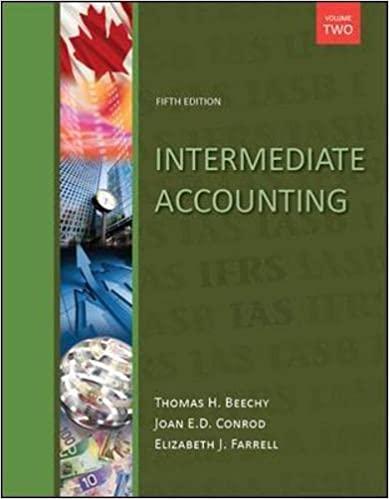Michael Bliss is the President, CEO, and controlling shareholder of Bliss Air Line Limited (BALL). He started
Question:
Michael Bliss is the President, CEO, and controlling shareholder of Bliss Air Line Limited (BALL). He started the company four years ago to provide low-cost charter service to holiday destinations. Although the airline is low cost, it is not no-frills; the airline's motto is "Travel with Bliss and have a ball!"
To obtain initial working finance, Michael sold a long-distance trucking company that he owned, and he invested the proceeds in BALL. The new company acquired four old Boeing 737-100 aircraft that had been decommissioned by other airlines and were parked in the Arizona desert. The purchase price was \(\$ 10\) million each. Approximately \(\$ 1\) million per plane was needed to get the planes ready for recertification and to equip the interior to Michael's satisfaction. The money for acquisition and refurbishment was provided by a collateral loan from GE Capital.
The airline was successful from the beginning, and in the second year the company bought three slightly newer airplanes, Boeing 737-300s, for \(\$ 25\) million each. These newer planes had not been decommissioned, and therefore they were able to enter service quickly to provide much-needed capacity in BALL's second summer season.
In the third year, BALL was again short of capacity and had to rent two more \(737 \mathrm{~s}\) from a major competitor that was no longer using them. The cost is \(\$ 115,000\) per month to rent.
It became apparent to Michael that the company would need much more capacity. As well, the rapidly rising cost of fuel, terminal charges, and overhead all pointed to a need to reduce operating cost per seat mile. The old 737-100 were much less efficient than the latest models. As well, new anti-pollution standards were being phased in, which would require the 737-100s to be either retired or re-equipped with new engines in three years.
Capital Structure Due to the need for new capital for expanded operations, Michael decided to make BALL a public company. The capital structure was altered to provide for four classes of shares.
1. An unlimited number of voting common shares;
2. An unlimited number of restricted common shares;
3. 70,000 non-voting retractable preferred shares; and
4. An unlimited number of non-voting, cumulative, non-participating preferred shares.
The voting common shares have 100 votes each. The restricted common shares have one vote each.
After approval by the securities commissions, the company issued the following:
- 150,000 voting common shares to Michael Bliss in exchange for his existing BALL shares;
- \(17,000,000\) restricted common shares issued at \(\$ 20\) per share in an initial public offering; and - 11,000 retractable preferred shares to GE Capital to replace the \(\$ 44,000,000\) collateral loan (i.e., for the first group of aircraft).
The restricted voting shares were listed on the Toronto Stock Exchange.
The retractable preferred shares carry an annual cumulative preference dividend of \(\$ 220\) per share. The shares are not callable for the first four years. After that, BALL can call any or all of the shares for redemption at \(\$ 4,100\) per share. At any time, if BALL misses a dividend, GE Capital will have the right to demand redemption at \(\$ 4,500\) per share plus accrued dividends.
New Equipment To provide additional capacity, the Board of Directors considered several possibilities. One was to buy new \(737-700\) s outright. The planes cost \(\$ 50\) million each, and would be financed by secured long-term floating rate debt, privately negotiated with major U.S. and international lenders. Preliminary indications were that BALL could obtain the necessary financing at a current rate of \(6.5 \%\). Industry practice was to amortize that type of aircraft over 20 years, assuming a \(10 \%\) residual value. Of course, the planes physically would last much longer if properly maintained, but obsolescence takes its toll.
A second alternative was to lease the new aircraft. A major leasing company indicated willingness to give BALL 14 -year leases at \(\$ 360,000\) per month per plane. Of course, BALL could combine the two alternatives-buy some planes and lease others.
The new aircraft would be used not only for fleet expansion, but also to replace the old \(737-100\) s, which soon would have to be retired. But to obtain more cash for operations (and new asset acquisition), the Board also was considering what to do with the three newer 737-300s. These planes had been purchased with instalment debt financing, and the Board thought it would be beneficial to "cash in" the ownership equity by entering into a sale-and-leaseback arrangement. Although the planes were becoming obsolete for top-tier airlines, they still were in demand by smaller airlines and by those in developing countries. Professional evaluations indicated that BALL could sell the planes for a profit of about \(\$ 2\) million each, and then lease them back for four years at \(\$ 125,000\) per month.
Recommendations Needed The end of the first fiscal year of public ownership is rapidly approaching. Before making any decisions about leasing and/or buying new planes, and about sale-and-leaseback of the 737-300s, Michael and the Board need a professional opinion on the financial statement implications. The CFO, Michelle Bliss, has retained you, FCGA, for advice on these issues. The Board also wants advice on any other financial statement issues that you see.
Required:
Write the report.
Step by Step Answer:






